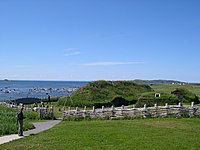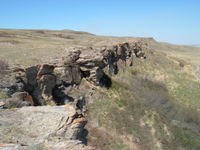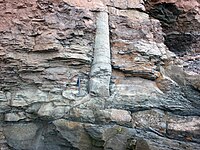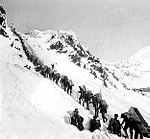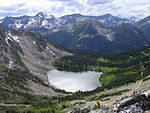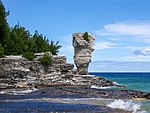World Heritage in Canada
The world heritage in Canada (as of 2019) includes 20 UNESCO world heritage sites , including nine world cultural heritage sites and ten world natural heritage sites, as well as one mixed site. Canada acceded to the World Heritage Convention in 1976, and the first two World Heritage sites were added to the World Heritage List in 1978.
World heritage sites
The following table lists the UNESCO World Heritage Sites in Canada in chronological order according to the year of their inclusion on the World Heritage List (K - cultural heritage, N - natural heritage, K / N - mixed, (R) - on the Red List of World Heritage in Danger ).
![]() Map with all coordinates of World Heritage Sites: OSM
Map with all coordinates of World Heritage Sites: OSM
| image | designation | year | Type | Ref. | description |
|---|---|---|---|---|---|
|
Historical National Site L'Anse aux Meadows ( location ) |
1978 | K | 4th | The L'Anse aux Meadows settlement is the only known Scandinavian settlement in North America. It only existed for a few years around the year 1000. | |
|
Nahanni National Park ( location ) |
1978 | N | 24 | Nahanni National Park Reserve is a 30,050 km² protected area in the southwest of Canada's Northwest Territories . The protected area was established in 1976. Due to unresolved legal issues between the Canadian federal government and the Dehcho First Nations, the area does not yet have the status of a national park, but this is still being sought. The park is one of the first to be declared a World Heritage Site by UNESCO. | |
|
Dinosaur Provincial Park ( location ) |
1979 | N | 71 | The Dinosaur Provincial Park is located in the Canadian Badlands in the valley of the Red Deer River in Alberta and is one of the richest locality of dinosaur fossils known. Fossil finds from the park are exhibited in museums around the world. The earth formation , in which most of the fossils are found in the park, is about 75 million years old and belongs stratigraphically to the Campanium . | |
| Kluane / Wrangell-St. Elias / Glacier Bay / Tatshenshini-Alsek | 1979 | N | 72 | This transnational World Heritage Site encompasses a large area of glaciers and high peaks on either side of the Canada-United States border. It also protects the largest non-polar ice field in the world. In 1979, the Kluane National Park ( Lage ) founded in 1976 in the southwest of Yukon in Canada and the Wrangell St. Elias National Park ( Lage ) in southeast Alaska, which is currently being established, were jointly added to the World Heritage List. In 1992 the Glacier Bay National Park ( Lage ) founded in 1980 in southern Alaska was added, and in 1994 the Tatshenshini-Alsek Provincial Park ( Lage ) in the far northwest of British Columbia , which was founded in 1993, adjoins the Kluane National Park and Glacier Bay National Park adjoins and connects them with one another. | |
|
SG̱aang Gwaii ( location ) |
1981 | K | 157 | SG̱aang Gwaii is the Haida name for Anthony Island, which is part of the Gwaii Haanas National Park in British Columbia . The abandoned Haida settlement of Ninstints (Nan Sdints), with its longhouse ruins and totem poles, is located within the park and illustrates the culture, art and way of life of the Haida.
Since 1994, the entire national park has been on the tentative list as a candidate for a mixed cultural and natural heritage site (Ref. 1938 ) |
|
|
Head-Smashed-In Buffalo Jump ( location ) |
1981 | K | 158 | The Head-Smashed-In Buffalo Jump is a historic, traditional hunting ground for North American Indians. The place is located in the province of Alberta , northwest of Fort Macleod . To hunt, the bison were first driven to the edge of a cliff along marked paths and then fell about ten meters into the depth. | |
|
Wood Buffalo National Park ( location ) |
1983 | N | 256 | The Wood Buffalo National Park is located in the border area of the province of Alberta and the Northwest Territories and was established in 1922. With an area of 44,802 km², it is Canada's largest national park. | |
| Canadian Rocky Mountain Parks | 1984 1990 (suppl.) |
N | 304 | The contiguous national and provincial parks in the Canadian part of the Rocky Mountains (the national parks Banff , Jasper , Kootenay , Yoho and the provincial parks of Mount Robson , Mount Assiniboine , Hamber added in 1990 ) illustrate the physical properties of the Rocky Mountains and contain important information about the evolution of the Earth. The Burgess Slate site in Yoho National Park was declared a World Heritage Site in 1980, but has not been listed separately on the World Heritage List since 1984. | |
|
Arrondissement historique du Vieux-Québec ( location ) |
1985 | K | 300 | The area includes the Upper City and the Lower City , the historic heart of Québec . It also includes the 4.6 km long city wall, the only remaining city fortification in America north of Mexico . | |
|
Gros Morne National Park ( location ) |
1987 | N | 419 | The Gros Morne National Park is located on the west coast of Newfoundland . With its 1805 km², the park, founded in 1973, is one of the larger Canadian national parks in the east of the country. The park was declared a World Heritage Site because of its geological history. | |
|
Old Town Lunenburg ( location ) |
1995 | K | 741 | Lunenburg is Canada's oldest German settlement and has a city center with distinctive wooden architecture. | |
|
Waterton Glacier International Peace Park ( location ) |
1995 | N | 354 | The Waterton Lakes National Park is located in the southwest of the Canadian province of Alberta and forms the Waterton-Glacier International Peace Park in conjunction with the US Glacier National Park . The two parks have been declared a World Heritage Site as one unit. The Waterton Lakes National Park was founded in 1895 and has an area of 525 km². | |
|
Parc national de Miguasha ( location ) |
1999 | N | 686 | The Parc national de Miguasha is located on the south coast of the Gaspésie peninsula and is a provincial park not even 1 km² in size in the west of the Canadian province of Québec . It was founded in 1985 and declared a World Heritage Site in 1999 because of its fossil sites. | |
|
Rideau Canal ( location ) |
2007 | K | 1221 | The Rideau Canal connects the capital Ottawa with Lake Ontario and is the oldest continuously used man-made waterway in North America. | |
|
Joggins Fossil Cliffs ( location ) |
2008 | N | 1285 | Joggins Fossil Cliffs, located on the cliff coast of the upper Bay of Fundy in Nova Scotia , is one of the world's most important sites for fossil plants and animals from the Upper Carboniferous . | |
|
Grand Pré cultural landscape ( location ) |
2012 | K | 1404 | The protected cultural landscape is bordered by the Gaspereau River in the east, the Cornwallis River in the west, Long Island in the north and the municipality of Grand Pré in the south. The cultural landscape shows the development of the agricultural arable land with its dykes and a lock system by the French settlers in the 17th century. | |
|
Red Bay - Historic Center of Basque Whaling ( Location ) |
2013 | K | 1412 | The town was a historical center of Basque whaling in the 17th century. | |
|
Mistaken Point ( location ) |
2016 | N | 1497 | At Mistaken Point, the oldest finds of multicellular life on earth - with fossils ranging from 560 to 575 million years old - were unearthed. | |
|
Pimachiowin Aki ( location ) |
2018 | K / N | 1415 | The area includes the land of four First Nations of the people of the Anishinabe and adjacent protected areas, including the Atikaki Provincial Wilderness Park in Manitoba and the Woodland Caribou Provincial Park and the Eagle-Snowshoe Conservation Reserve in Ontario | |
|
Writing-on-Stone / Áísínai'pi ( location ) |
2019 | K | 1597 | Writing-on-Stone Provincial Park, called Áísínai'pi in the Blackfoot language (it is recorded), is home to the largest collection of rock art in North America's Great Plains and is a sacred site of the Blackfoot . |
Tentative list
The sites that are intended for nomination for inclusion in the World Heritage List are entered in the tentative list .
Current World Heritage candidates
As of 2019, eleven sites are entered in the tentative list of Canada, the last entry was made in 2018. Due to the designation as a World Heritage Site, one site was moved from the tentative list in 2019.
The following table lists the sites in chronological order according to the year of their inclusion in the tentative list.
![]() Map with all coordinates of current World Heritage candidates: OSM
Map with all coordinates of current World Heritage candidates: OSM
| image | designation | year | Type | Ref. | description |
|---|---|---|---|---|---|
|
Gwaii Haanas National Park ( location ) |
2004 | K / N | 1938 | National park in the southern part of the archipelago of Haida Gwaii (Queen Charlotte Islands)
The island of SG̱aang Gwaii (Anthony Island), part of the national park, has been a UNESCO World Heritage Site since 1981 (Ref. 157 ) |
|
| Ivvavik / Vuntut / Herschel Island (Qikiqtaruk) | 2004 | K / N | 1939 | The protected area stretches for 15,500 km 2 along the Yukon and includes the Vuntut National Park ( location ), the Ivvavik National Park ( location ) and the Herschel Island - Qikiqtaruk Territorial Park ( location ). | |
|
Quttinirpaaq National Park ( location ) |
2004 | K / N | 1943 | Among other things, the Barbeau Peak (2,616 m) is located in the national park . | |
|
Tr'ondëk-Klondike ( location ) |
2004 | K | 6255 | The proposal includes Tr'ochëk , Chilkoot Trail , Klondike Goldfelder, and Dawson , among others . A transnational application is planned together with the USA . | |
| Île d'Anticosti | 2018 | N | 6336 | ||
| Hecate Strait and Queen Charlotte Sound Sponge Glass Reef Marine Sanctuary | 2018 | N | 6338 | The nominees are Hecate Strait and the Queen Charlotte Sound Glass Sponge Reef Marine Sanctuary | |
| Qajartalik | 2018 | K | 6339 | Qajartalik is a unique rock art site in the Arctic that includes innumerable petroglyphs. | |
| Sirmilik National Park and Tallurutiup Imanga (planned) National Marine Conservation Area | 2018 | N | 6340 | ||
| Stone valley | 2018 | N | 6341 | ||
| Wanuskewin | 2018 | K | 6342 | ||
| Yukon Ice Patches | 2018 | K | 6343 | The Yukon Ice Patches are a group of internationally significant archaeological sites in the southern Yukon . |
Former World Heritage candidates
These sites were previously on the tentative list, but were withdrawn or rejected by UNESCO. Sites that are included in other entries on the tentative list or that are part of world heritage sites are not taken into account here.
![]() Map with all coordinates of former World Heritage candidates: OSM
Map with all coordinates of former World Heritage candidates: OSM
| image | designation | year | Type | Ref. | description |
|---|---|---|---|---|---|
|
Lancastersund ( location ) |
1980-1996 | N | Habitat for polar bears, whales, snow geese etc. | ||
|
Funk Island ( location ) |
1980-1996 | N | A breeding ground for many species of birds | ||
|
Prince Leopold Island ( location ) |
1980-1996 | N | A breeding ground for many species of birds | ||
| Lac la Ronge or the parks of Quetico | 1980-1996 | N | The Lac la Ronge or the Quetico Provincial Park | ||
|
Thompson River ( location ) |
1980-1996 | N | |||
| The Great Lakes (Bai de George / Fathom Five) | 1980-1996 | N | The Bai de George and the Fathom Five National Marine Park on the edge of the Great Lakes | ||
|
The pingos of Tuktoyaktuk ( location ) |
1980-1996 | N | Sanctuary for pingos (earth-covered ice cores) near Tuktoyaktuk
|
Web links
- Canada on the UNESCO World Heritage Center website.
Individual evidence
- ↑ Canada. In: whc.unesco.org. UNESCO World Heritage Center, accessed July 10, 2017 .
- ↑ German names according to the World Heritage List. In: www.unesco.de. German UNESCO Commission, accessed on July 6, 2019 .
- ^ Tentative list of Canada. In: whc.unesco.org. UNESCO World Heritage Center, accessed July 6, 2019 .
- ^ Former Tentative Sites of Canada. In: World Heritage Site. Retrieved July 10, 2017 (English).


